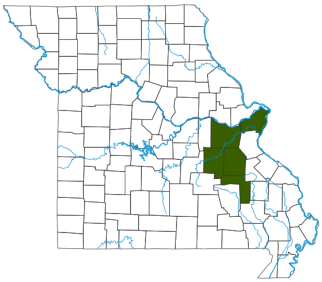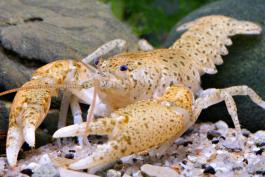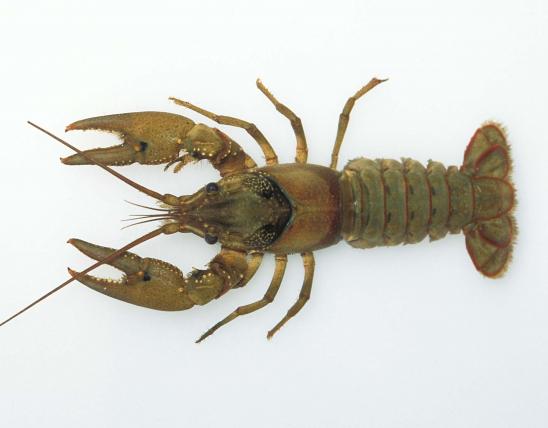
The freckled crayfish is a powerfully built, yellowish-tan crayfish with numerous conspicuous black spots on its pincers, carapace, and abdomen. It is distinguished from all other species within its limited range by the pattern of conspicuous black spots over the entire dorsal (top) surface. As with many Ozark crayfish, the river system it occurs in is a big clue for identification.
Adult length: about 2 to 3¼ inches.

This crayfish occurs only in the Meramec River basin of the Missouri Ozarks, especially the eastern and central areas of the basin, the Courtois Hills.
Habitat and Conservation
The freckled crayfish lives in the very clear, high-gradient, spring-fed streams and small rivers of the Meramec Basin. Rarely seen in the open, it digs burrows in gravel beneath large rocks and stays there, probably emerging at night to feed. Where it occurs, it is not as abundant as the other crayfish that live in the same streams.
Food
Crayfish are generally omnivores, eating a wide variety of plant and animal materials.
Status
The freckled crayfish has a very limited range within Missouri and occurs nowhere else in the world (it is endemic to our state). It is a Missouri species of conservation concern, and it is vulnerable to extinction. It was first described scientifically as a new species in 1988.
Life Cycle
Mating probably occurs in the fall, and females have been observed carrying eggs in May. Apparently they carry eggs about a month later than do female spothanded, golden, and saddlebacked crayfish, which often occur in the same areas. Freckled crayfish apparently can live to about 4 years of age.
Human Connections
Crayfish are eaten by many types of wildlife, including species that humans hunt and fish. Crayfish are fascinating, colorful creatures and are part of our rich native heritage.
Species of conservation concern, such as this one, are protected from harvest by state law.
Ecosystem Connections
Crayfish are an important link in the food chain between plants and other animals, breaking down plant materials that are resistant to decay. Crayfish in turn are an important food for many other animals.
Presence of crayfish in a stream or pond usually indicates good water quality.
























